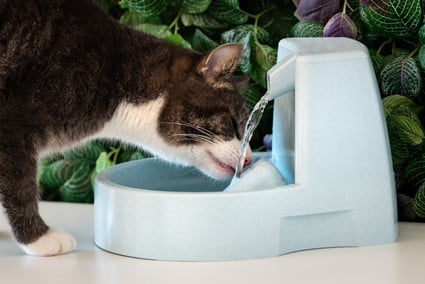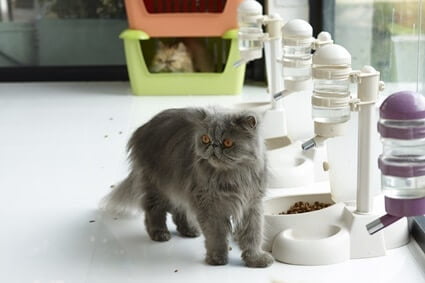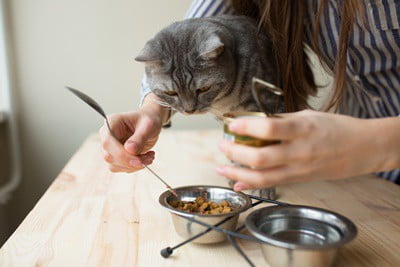The placement of your cat’s food and water bowls may seem arbitrary. In fact, many owners place the two bowls directly next to each other. While some cats adapt and show no issues with this, others will rebel. Your cat may refuse to drink the water, knock the water dish over, or drop food into its water bowl.
Your cat’s water bowl should be placed 3-5 feet away from its food bowl. Many cats cannot stand the scent of food near their water. In the wild, mixing food and water often results in bacterial growth and illness. Cats may also want to drink and eat in different places so that they can hide from predators. Even the act of hunting down the different bowls in different places can feel more natural to a cat.
For scared or jumpy cats, it can feel risky to eat and drink in the same place. The best solution is to gradually move the water dish away from the food dish, a few inches at a time. Separating the bowls all at once may distress some cats, especially those that are already protective of their food or water.
Do Cats Like Their Water Next to Their Food?
While it may seem trivial, your cat will have strong opinions about where its water and food dishes are placed. Most importantly, it won’t like having these two bowls directly next to each other.
Some cats will refuse to eat out of a bowl that’s near water. Likewise, other cats will drink out of the toilet, sink, potted plants, and even puddles before sipping from a water dish near food.
That’s all credit to your cat’s base instincts. Humans have domesticated felines for thousands of years as pets and a natural pest control solution. However, cat genes have changed little over the millennia. Cats have not been as extensively bred as certain dog species have. This means that their hunting instincts have yet to be bred out as well.
It’s no surprise that your cat will tend to show the same preferences as its wild ancestors. Even though it’s a house pet, it still interacts with its food and water using the common sense of its wild counterparts. Keeping the water dish about 3-5 feet away from its food will help the cat feel like it’s exercising a good amount of caution.
Why Do Cats Not Like Water Near Their Food?
Cats dislike having water near their food, but the reasoning behind it can seem petty. That’s especially true if you move the water dish a few feet to the left and find the cat accepting it all of a sudden. In truth, cats have very sensible reasons for this petty habit:
Avoiding Predators
In the wild, cats will often drink water, go to the bathroom, and eat in different places. This is to ensure that other animals will not catch their scent or invade their territory. While your indoor cat doesn’t need to worry about predators or rivals, this instinct remains intact.
Avoiding Sickness
Cats that eat, drink, sleep, and defecate in or around the same spot will often find their food and water contaminated by harmful bacteria. That can lead to the cat getting ill in short order. Your cat will prefer that all its belongings stay in their own spots around your home. Grouping them closely together, in your cat’s mind, is the same as inviting illness.
Enjoying Hunting Instincts
The Madison Cat Care Clinic found that cats do not typically eat large, infrequent meals throughout the day. Unlike humans, cats will hunt small prey and consume around 10 to 20 smaller meals on a good hunting day. Of course, none of these meals are found in the same place. A cat needs to look for them.
With that in mind, your cat will be more likely to eat and drink if it needs to hunt for it. You can encourage your cat’s innate instincts by placing its water and food bowls in different locations around your home. When it has to search out these resources, it will feel more trusting of them. It did all the hard work of finding them, and that feels more natural.
Hiding Places
Cats are both predators and prey, and they understand that drinking and eating make them vulnerable. After all, their heads will be down, and they’ll be busy with the water or food. This gives any predators a great chance to sneak up on them.
By placing the water and food bowls in different locations, your cat will have more options. It can eat in one secluded place, drink in another, and even pick from additional food and water spots.
If your cat is new to your home, that can help it feel more protected and less exposed. Even if one spot is ‘compromised’ by foot traffic or a loud AC unit, a different place will feel safe.
Do Cats Need Water if They Eat Wet Food?
If your cat is being especially picky and refuses to drink from its water dish, you may be looking for a compromise. What if you just gave it wet food instead? Then it wouldn’t need to bother with the water dish.
Cats do obtain much of their water intake from their meals. In fact, it’s easy for cats to become dehydrated since they don’t have a strong thirst drive. Their body tissue is made up of about 67% water and will try to replenish this from:
- Canned wet foods, which are usually made up of around 60-75% percent water
- Smaller prey they find and consume throughout the day
Because of this, some cat owners mistakenly believe that their cats do not need to drink water if they feed them only wet foods. However, according to Cornell University, cats will still need to drink water every day to stay healthy. It doesn’t matter how much wet food you feed them.
While wet foods may have a large amount of water content, they may not have all the nutrients your cat needs. Indeed, many veterinarians will recommend different diets based on your unique cat’s situation. Some cats might need an all-dry-food diet, while others will need a combination of both wet and dry foods.
Of course, this means that you will have to provide your cat with fresh water. Even if it’s simpler to just give your cat wet food, you must convince it to use the water dish.

Why Do Cats Put Food in Their Water Bowl?
You’ve separated your cat’s food and water bowls. The cat appears to have accepted this. However, in a surprising turn of events, your cat picks up bits of food and drops them inside the water bowl. Is your cat trying to make wet food?
Rest assured, your cat isn’t trying to soften its existing food or transform a toy into a meal. Instead, it’s just an instinctual response that the cat inherited from its wild ancestors.
Cats in the wild take their prey back to their shelters and enjoy their meals privately. This shelter will likely be close to water and other necessities (but not directly next to them). If your cat doesn’t have multiple hiding spots, then the location of its water bowl might feel like the safest point in your house. As such, the cat will eat its food in this particular spot.
Once the cat has eaten its dampened food, it may then find itself in a real pickle. It’s just contaminated its own water, and therefore, the water can’t be safely consumed. In response, the cat will then ignore the water. That’s true, even if it’s the one that dropped something inside in the first place! To contend with the fickle creature and its mistake, change the cat’s water.
Even if it seems like a good solution, you should avoid moving its food closer to the water. Rest assured that the feline hasn’t overcome its aversion to having water and food close to each other. It just got its wires crossed and didn’t know how to reverse the mistake. In the wild, it would’ve just used a different hiding place where it felt safe bringing food. In your home, it didn’t have options, so it picked its own water dish.
Cat Food And Water Bowls Next To Each Other
What if your cat was accepting its water bowl before, no matter its placement, but now it’s rejecting it? If your cat picks up this habit suddenly, it’s likely because of:
Bowl’s Material
Cats tend to be very picky about the material of the bowl they will drink water out of. You may need to go by trial-and-error to see which bowls your cat prefers.
Plastic bowls might be cheaper, but your cat may dislike how its whiskers cling to the surface. Stainless steel, porcelain, and glass bowls are designed to keep water cool all day long. These tend to work best for even the pickiest cats.
Bowl’s Smell
Cats are also very sensitive to smell. If a plastic bowl still has a chemical residue or mildew growing along its surface, your cat may refuse to use it at all. The same holds true if you give the cat a different pet’s bowl, or swap out a food bowl with a water bowl.
Cats tend to snub their water if they smell food, and vice versa. Be sure to change the water frequently and sanitize the bowl on a weekly basis. This should eliminate the smell.
Stagnant Water
Some cats hate water bowls altogether. You might find that your cat prefers to drink water from a running source, such as a sink or hose. Still pools of water may put a cat on edge, as bacteria tend to fester in these areas.
Of course, you cannot leave your kitchen sink perpetually on, just in case your feline wants a sip every now and then. In this case, you can buy a tiny water fountain for the cat to drink out of. These fountains keep the water flowing, and some even have charcoal filters. This ensures the water cycling through it stays clean and fresh for your cat to drink.
Where Should I Put My Cat’s Water Bowl?
If you’re separating the food and water bowls, their placement may seem arbitrary. However, your cat will have a preference and may refuse a bowl that’s in the wrong spot. The most ideal places will include:
- The kitchen
- Your bedroom
- By your back door
- In the living room
Deciding where to put cat food and water bowls also includes a couple of unique factors:
Move Around Other Items
You will still have to keep your cat’s belongings as far from each other as your home will allow. This might include putting them on opposite sides of a room. It won’t disguise the scents, but it will offer your cat the illusion of space.

Space Out The Bowls A Little At A Time
Be sure to move your cat’s food and water bowls gradually. Don’t just reposition them all at once! For example, start by moving the water bowl a few inches away from its food bowl. If your cat responds positively to this change, you can then move the bowl further out.
Always give your cat the option of returning its bowl to its original position. It may throw a fit about the sudden change. If it does, return it to the spot and adjust it at a slower pace.
Use Multiple Bowls
If you want to completely move your cat’s water bowl from its current location, it is best to set up a new water station elsewhere in your home first. Once your cat starts to migrate to that bowl, you can move the first bowl to the new spot.
Cats can share water bowls, but it will depend on their personalities. Some will have no issue sharing, especially if they were raised with the other cat. Others may be highly defensive of their food and water, especially if they’re former strays or rescues. You will have to discover this through trial and error.
If your cats appear to share without a problem, then let them continue. If there is conflict, then do not force the matter. Cats forced to share food, water, or other resources will fight more often or bully any new cats away from their territory. They may also drink too quickly in an attempt to get their fill. This can result in stomach aches and other digestive issues later on.
In that event, get each of your cats their own special water bowls or fountains. Be sure to place each in their own special spot, reserved just for that cat.
All in all, a cat’s water bowl should be placed away from its food dish. This ensures your cat feels calm, safe from illness, and protected from rivals. By trying different materials, separating the two bowls, and even providing several bowls, your cat should warm up to the set-up.

